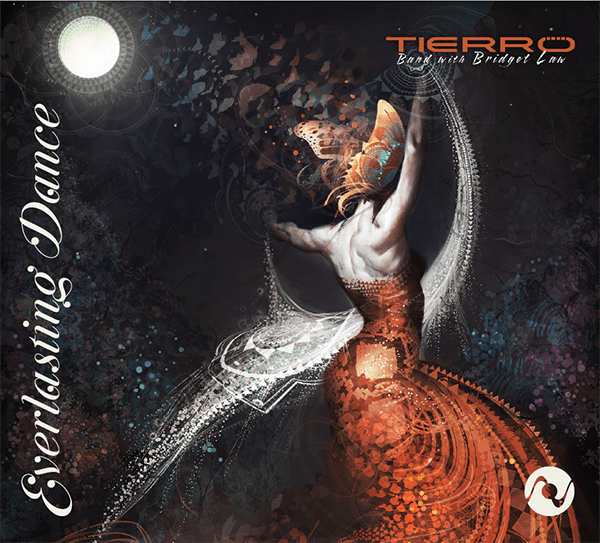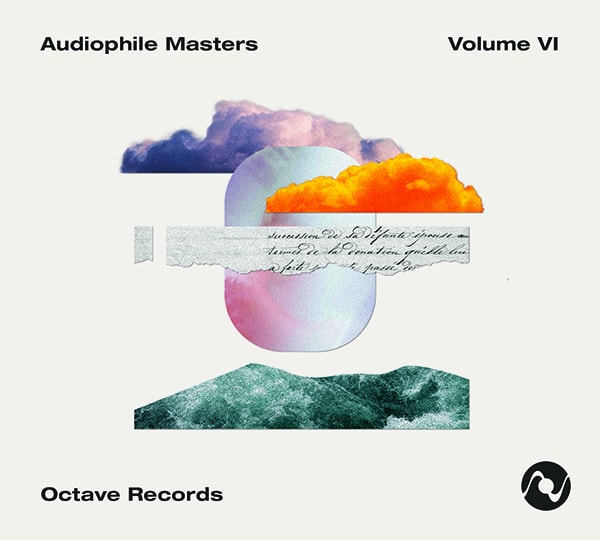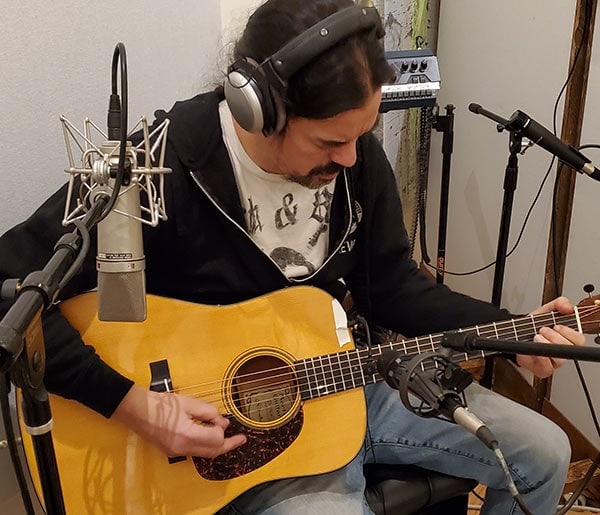Octave Records has two new releases for your musical and audiophile enjoyment: Everlasting Dance by the “Gypsy Grass” group TIERRO Band with Bridget Law, and Audiophile Masters, Volume VI, the latest in Octave’s series of reference-quality sampler discs.
Everlasting Dance combines world music, bluegrass, country, Americana, jazz and other not-so-categorizable influences. Like Audiophile Masters, Volume VI, It’s recorded in high-resolution DSD and SACD using Octave’s proprietary recording and mastering system and new premium gold disc formulation.
The band features Tierro Lee’s dazzling acoustic and electric guitar playing, and the fiddle and vocals of Bridget Law. The other musicians include Charles Parker Mertens (acoustic bass), Jonny Jyemo (percussion) and Nabin Shrestha (tabla), along with guest vocalists Bonnie Paine, Xerephine, and Megan Letts. Together, they bring a world of experience to the making of Everlasting Dance. Tierro Lee is lead guitarist for blues legend Otis Taylor, and Bridget Law is the founder of Americana group Elephant Revival. Mertens has studied ragas in India and toured with Thievery Corporation and Rapidgrass.

(Scroll down for our interview with Tierro and Bridget.)
Everlasting Dance was recorded mostly live by GRAMMY-winning engineer Mike Yach at Animal Lane Studios in Lyons, Colorado using Octave Records’ Pure DSD process and the Sonoma multi-track DSD recording system. It features Octave’s premium gold disc formulation, and the disc is playable on any SACD, CD, DVD, or Blu-ray player. Everlasting Dance (SRP: $19 – $29 depending on format) also has a high-resolution DSD layer that is accessible by using any SACD player, a PS Audio SACD transport, or by copying the DSD tracks on the included DVD data discs. In addition, the master DSD and PCM files are available for purchase and download (including DSD64, DSDDirect Mastered 192kHz/24-bit, 96kHz/24-bit and 44.1kHz/16-bit PCM), along with Octave’s newest addition, 24-karat gold CDs at standard resolution. These CDs have been cut directly off the DSD master using BitPerfect’s state-of-the-art Zephiir filter.
From the beginning cymbal crash and Lee’s driving guitar on the opening track, “Dorset of Perception,” the album immerses listeners in a feast of worldly musical influences and varied rhythms. The musical styles range from the outlaw-country “Gypsy Weed” to the introspective violin-featured ballad, “Sitka,” and the driving beat and nylon-string acoustic guitar of “Casa Latina.”
******

Audiophile Masters, Volume VI offers an eclectic selection of music, including flamenco guitarist Miguel Espinoza, the avant-jazz Seth Lewis Quintet, the classical piano and vocal group, Duo Azure, plus a strong selection of rock, pop, Americana, and other not-so-categorizable music. It’s available in the same formats as Everlasting Dance (SRP: $19 – $29) and was recorded using Octave Records’ Pure DSD process.
The album kicks off with a flourish, with Miguel Espinoza’s dazzling “Journey Home,” featuring flamenco guitar, cello, bass and percussion. The Seth Lewis Quintet navigates through harmonic twists and turns with the contemporary jazz of “Dream Theme.” There’s plenty of pop, country and Americana courtesy of Bonnie and Taylor Sims’ contemplative “Sleep,” Dylan McCarthy’s bluegrass workout “Marigold,” the piano- and vocal-driven title track from Clandestine Amigo’s Things Worth Remembering album, and the irresistible funk/rock/pop “Drug of Choice” from Dechen Hawk. Duo Azure offers “Liederkreis, Op. 39, no 6 – Schöne Fremde,” a beautiful classical piece for piano and voice. Additional selections from accordionist/vocalist Alicia Jo Straka, singer/songwriter Monica Marie LaBonte, and the marimba/handpans duo More Than Physics round out the album with the ethereal “Why We Fell In Love.”
******
We interviewed Tierro Lee and Bridget Law about the making of Everlasting Dance.
Frank Doris: How did everybody in the band meet? You have quite a variety of different players and styles.
Bridget Law: We met because the singer for his band fell in love with my best friend! So, we were basically the instrumentalists who were backing them up.
Tierro Lee: We hit it off musically right away. It was a spark that everybody in the room felt. When we first jammed together, which was live on a stage, everybody in the room felt that magic. It sort of felt like Bridget and I were flirting, musically, in front of all of these people.
We’ve both known almost all of the other musicians, but we met them in a variety of different paths.
BL: By 2014 we were playing together, and this is our second studio album.
FD: You have all these disparate elements, like tablas, flamenco guitar, violin, and it doesn’t feel forced. It has all these elements, but it doesn’t sound like they’re clashing. Was that a conscious thing, or did it just happen?
BL: I think it’s the type of musicians we are. We pick the pieces that work for us and work and then kind of thread them into our own expression of music. For example, I’m really inspired by Hungarian gypsy fiddle players. I haven’t necessarily learned the entire genre, but I’ve been around it enough to know what the scales are and to feel the soul behind what they’re playing. Tierro has certainly done that with Latin and Arabian and using likes to use Hijaz scales. We can kind of speak a few musical words in this language and speak a few musical words in that language.
TL: The musicians in the band are just so good, it feels really natural. The other thing I want to say is that on the record, it does sound like everything was really easy, but it was so much work. There are compositions on that record that took years of playing them live and tweaking to get into a place where it was like, OK, this is really where it should be.
BL: During the beginning of quarantine, our son was born. When he was about nine months old, we flew to Canada and quarantined for two weeks in a lake house up in Northern Ontario. And that’s basically where we really pulled this record together. That’s where we wrote “Gypsy Weed.” That’s where we arranged “Everlasting Dance” and “Casa Latina.” That’s where the bulk of it came together, whether it was stuff that we had worked on for years or [newer songs].
FD: Which answers the question I was going to ask about how the pandemic has affected your music. The other half of the question is, what does everybody do going forward?
BL: I don’t think we let the pandemic get in the way of the music, at least the making of this album. Of course, we didn’t play shows and things like that, but we definitely made use of the quiet space in order to put down some really special material.
TL: 80 percent of that happened live and, and about 20 percent I think it’s fair to say overdubs.
I probably wouldn’t have been so motivated to make a record if it wasn’t for the DSD recording process. It’s definitely a format that I like. It’s the only format I like to record records on, now. I’ve been an audio engineer for about 15 years. And, and I got very deep into [high-resolution audio] very early on. And at the end of the day, I tell people that if I’m working in DSD, I can mix, I can record for 10, 12 hours a day. And at the end of my 12-hour day, my ears feel fine and I’d be happy to keep going. If I’m doing that at 16-bit/44.1 audio, give me four hours and I don’t want to do it anymore.

Tierro Lee.
BL: It’s like DSD captures the space between the notes more accurately, which allows you to hear so much dimension; you hear where everything [in the mix] sits in an almost physical way.
FD: I should get back to talking about the music because I’ll go totally audio geek if we don’t!
TL: “Casa Latina” is a song that was inspired because I was so in love with that flamenco sound and the Latin American culture. That song kind of came out of longing for that experience of being in a Latin American country and feeling their music and that heart and the love for the music. For years and years, I tried to capture that on my own and just failed for years and years and years. But I think I finally got it with that song.
BL: The original title of “Everlasting Dance” is actually “Gwen’s Everlasting Dance.” Gwen was my ballet teacher growing up. She was in her 70s and was really special in my life. I carried her obituary around in my fiddle case. And then one day I sat down by the river and I opened up the fiddle and I was like, all right, Gwen, let’s dance. And out comes this crazy gypsy fiddle tune, which is very unlike my classical ballet teacher.
BL: You asked before; where are we going from here? We have a whole other album that was sort of recorded with a different intention, kind of more “produced” version of a lot of these songs [and others].
TL: We’re doing some more gigs now that things are gonna open up a little bit, and we want to support the record and get out there. We’re playing the Sonic Bloom festival [at Hummingbird Ranch, Colorado June 16 – 19].
BL: We’ve got a couple of local shows, like the Niwot concert series, and then we do this kind of fun beach party in Buena Vista. We don’t have a ton of gigs. But we’re looking forward to getting back at it as things open up.
The shows have become more of a sacred experience. You never take them for granted anymore.
Header image: TIERRO band with Bridget Lee.













0 comments